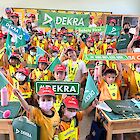“Leave no one behind” is the central guiding principle of the 2030 Agenda adopted by the United Nations in 2015. In your view, where do we stand and how realistic is it to achieve the formulated development goals, especially in view of the still alarming living conditions of many children?
We’re past the halfway mark towards achieving the Sustainable Development Goals and only 15 per cent of the SDGs are on track. So, despite the remarkable advancements that we have made in several areas of development, the world is not becoming a safer place for children. Instead, they’re living through a polycrisis – with climate change and environmental degradation, economic downturn, public health emergencies and heightened levels of conflict and war impacting the most marginalized disproportionately and threatening children’s rights. While progress for children has not been equal, the data shows that change is happening. Now is the time to urgently close the remaining gaps and put in the focus and investment needed to accelerate progress to achieve the child-related SDG targets. Protecting children at the forefront of the climate crisis is integral to this.
To what extent is UNICEF focusing on human-made climate change and how does this specifically affect work for and with children?
There are one billion children that are at extreme risk from climate change, challenging their ability to survive, grow and thrive. Climate change is a crisis for children, both now and for their futures. UNICEF is committed to helping governments and communities build low-carbon, resilient essential services for children; equip young people to be champions for the planet and accelerate a just transition to a nature-positive and carbon-neutral world. We can’t do this alone – we need partners including governments, United Nations agencies, the private sector and civil society – to protect children from the worst impacts of this crisis. And of course, children and young people have been largely absent from the negotiating rooms, but UNICEF is committed to changing that.
What concrete measures is UNICEF taking to promote sustainable development?
UNICEF’s goal to help one billion children at extremely high risk from climate change reflects our ongoing commitment to fulfil the promise of the SDGs. We plan to achieve this by boosting communities’ resilience to protect the lives, health and wellbeing of their children, while empowering the next generation of climate champions and helping countries to reduce their carbon emissions through sustainable and climate-smart programmes. And we think that aligning development and humanitarian approaches will lead to better results for children and is a cost-effective way to strengthen the ability of vulnerable communities to withstand shocks over time. This work means building early warning systems, building schools in hurricane-prone areas that are climate and disaster resilient and by making sure that there’s cash assistance for families living in humanitarian crises so that girls, for examples, are not as vulnerable to child marriage.
What successes has UNICEF achieved so far in terms of sustainable development and what challenges remain?
As I mentioned, the data shows there has been success on the child-related SDG indicators, even if that progress isn’t always equal. One fact that can give us hope is that more children are surviving today than ever before, with the number of children who die before their fifth birthday reaching a historic low. This took decades of commitment by individuals, communities and countries to reach children with low-cost, quality and effective health services. But the poorest and most vulnerable children continue to bear the brunt of the failure to meet all of the global goals at this halfway point. Increasingly children are under attack in conflict zones and at risk from climate-related disasters. UNICEF is committed to accelerating progress on the SDGs before it’s too late, increasing our support for the most marginalized children, and helping to build resilient systems that sustainably provide the services children need to survive and thrive, even when faced with the shocks linked to climate change. And through all this upheaval, upholding children’s rights must always be non-negotiable.
How can companies and individuals support UNICEF in achieving sustainable development goals?
To meet our ambitious goals for children, we need the private sector to join us. Not only for its tremendous untapped potential to move towards low-emission, climate-resilient investments, but also because it also has the expertise, resources and capacity to effect substantial transformations in addressing global challenges with innovation, speed and scale. UNICEF has made significant efforts to future-proof its work, which is becoming increasingly important in a world of unprecedented challenges and emergencies that can come from anywhere. Building resilience today is the best way for every child to survive and thrive in the future and the private sector can play a pivotal role in this. It's an exciting time to join us on the climate agenda. We are actively pursuing new public-private financing to implement ambitious sustainable development for children through broad sources of capital, such as green bonds, carbon credits, blended finance, guarantees, debt swaps, outcome-based financing and parametric insurance.
My main message is this: investing in child-responsive and child-sensitive climate finance is a smart business decision. For example, when you invest in children’s early years development, you get a triple dividend – you increase long-term capacity, protect individual potential and foster human development. Helping children ultimately helps everyone.



















































